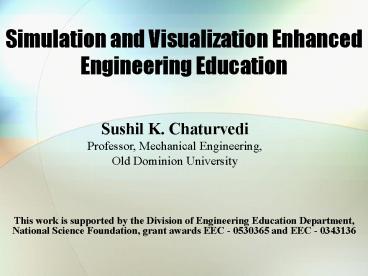Simulation and Visualization Enhanced Engineering Education - PowerPoint PPT Presentation
1 / 17
Title:
Simulation and Visualization Enhanced Engineering Education
Description:
Sushil K. Chaturvedi Professor, Mechanical Engineering, Old Dominion University This work is supported by the Division of Engineering Education Department, National ... – PowerPoint PPT presentation
Number of Views:60
Avg rating:3.0/5.0
Title: Simulation and Visualization Enhanced Engineering Education
1
Simulation and Visualization Enhanced Engineering
Education
Sushil K. Chaturvedi Professor, Mechanical
Engineering, Old Dominion University
- This work is supported by the Division of
Engineering Education Department, National
Science Foundation, grant awards EEC - 0530365
and EEC - 0343136
2
Objectives
- Develop web-based modules for student learning,
using computer-based simulation and
visualization. - Assess effectiveness of web-modules for student
learning. - Dissemination of web-modules.
- Develop collaborations and partnerships with
regional, national and international institutions.
3
Engineering Education Poised for a Change
- Students are technology savvy In future,
learning will be increasingly in visual domain . - Changing student demographics Part-time
students demand for education in anytime /
anywhere mode. - Industry increasingly seeks graduates who are
adept at designing, analyzing, manufacturing on
the Internet.
4
Engineering Education Poised for a
Change(continued)
- Hands on experience in virtual domain versus
physical domain. Physical hardware is expensive.
Computer simulation of physical phenomenon is
often more cost effective. - Distance learning networks Engineering
education for remote users. - Engineering education on a transnational scale -
- Cooperation among institutions on a global
scale
5
Modes of Engineering Education
Conventional Learning
Technology Enhanced Learning
Distance Learning
TESL Technology Enabled Self Learning
(Student-Centric Learning)
TEL Technology Enhanced Learning
TCL Teacher Centric Learning
Mixed Mode of TCL SCL, Classroom and the
Internet
Conventional , Classroom
Distributed Learning on the Internet
6
Who is Involved In the NSF Project ?
7
Research Methodology
- Web-based modules for classroom and laboratory
instructions are being developed using the
pedagogy of Learning by Doing in the Virtual
Environments - Use Simulation and Visualization software tools
to create a dynamic learning environment to
enhance student learning of basic engineering
principles and applications.
8
Research Methodology (continued)
- Incorporate in the web-based modules five
characteristics namely Interactivity,
Interconnectivity, Practicality, Hierarchy, and
Viscompana (Visualize, Compute, Analyze) - Development of tools to assess learning
objectives and outcomes for modules developed and
implemented.
9
Modular Characteristics
10
Modular Characteristics (continued)
- In order to maximize the impact of simulation
and visualization, a module should include an
optimal mix of following five characteristics
that have been identified for the curricular
transformation. These modular characteristics are - Interactivity
- It refers to students ability to interact with a
web-based module.
Figure shows a web-based supersonic nozzle
visualization module designed to teach students
about one-dimensional compressible flows.
11
Modular Characteristics (continued)
Figure shows visualization of flow property
variations by the clicking action of the mouse
that acts like a measuring probe.
12
Modular Characteristics (continued)
- Practicality
- This characteristic relates to a modules
emphasis on engineering context (real world
aspects) of engineering principles and governing
equations underlying the module.
Figure shows a web-based supersonic nozzle
visualization module designed to teach students
about one-dimensional compressible flows. The
supersonic nozzle visualization module helps
students relate an observed phenomenon to
operating parameters that govern it.
13
Modular Characteristics (continued)
- Interconnectivity
- It describes a modules capability of building
on students knowledge and experience in preceding
courses or subject materials and projecting that
to future learning.
Figure illustrates interconnectivity between the
topical areas of mixtures, combustion and
one-dimensional gas dynamics.
14
Modular Characteristics (continued)
- Hierarchy
This refers to a modules capability of guiding
students from elementary considerations to more
advanced learning through sub-modules that are
embedded into one-another, with succeeding
sub-modules providing a higher level of learning
compared to the preceding one.
Figure shows the hierarchy characteristics of the
web-based jet propulsion module that will
facilitate exploration by students of topics and
aspects that are normally not covered in
conventional classroom setting.
15
Modules for Demonstration
- Steam Power Cycle Junior / Senior Lecture
Courses http//www.mem.odu.edu/steampower - Jet Impact Force Junior Virtual Experiment
for a Laboratory Course http//www.mem.odu.edu/jet
force
16
Conclusions
- From student feedback and assessment of
student performance, we conclude that web-modules
- are excellent tools for supplementation of
class-room instruction modules provide detailed
information and means to explore further - Can facilitate learning in anytime / anywhere
mode promote self-learning - Can also be excellent remedial tools
- Student performance as measured by test scores
has shown improvement
17
- Thank You !































